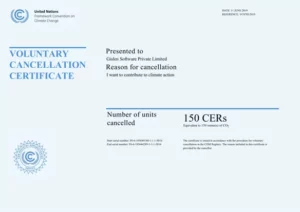We are proud to announce that we are a carbon-neutral company. Our journey towards carbon neutrality started in 2013 when we invested in solar panels on our roof. Since then, we have bought more, replaced light tubes with LEDs, and replaced our old ACs with more efficient ACs. Thanks to our solar panels, we don’t need diesel generators to manage power cuts.
However, to run our business, we still can’t help produce some carbon dioxide by flying to meet our European clients, providing food for our staff, transporting, etc. However, we need to live, and then our objective is to ensure that whatever impact we can’t help having is compensated and that our net effect on the environment is as small as possible.
Our estimate shows we produced about 150 tons of carbon dioxide during the last accounting year. We have probably not covered every aspect of our business. To be on the safe side, we compensated for 565 tons instead. We, therefore, believe we can confidently claim to be carbon-neutral!
How we started focusing on the environment
In 2013, the power situation in South India was deplorable. Many companies bought diesel generators. Instead, we purchased our first solar panels. The reason was environmental, and we thought it would be an excellent investment.
We had to change our old ones into inverter ACs to run our air conditioners on solar electricity. Since inverter ACs are much more energy-efficient, we substantially reduced our electricity consumption from the grid. On cloudy days, we don’t have enough sun to have sufficient reserve energy. Therefore, we rent a petrol generator during the monsoon for emergencies. However, we have only had to use it on very few occasions.
New investments
We recently replaced our old inverters with new, more efficient ones and exchanged lead batteries for Lithium-Ion batteries, which give much longer backup time. We have also applied for net metering, which allows us to export surplus electricity to the grid. Especially on Saturdays and Sundays, we only use power for our server room. This could reduce both our electricity bill and electricity consumption in our area.
How did we become carbon-neutral?
Even though, as per our calculations, we had a carbon footprint of about 150 tons, we still compensated for 465 tons of carbon dioxide. There are various reasons for offsetting for more than our known footprint;
- We may have missed some.
- CO2 from airliners affects the environment more than when producing CO2 at sea level
- The United Nations audits our compensation programs, but we can’t be 100% sure that all of them are valid.
- By offsetting more, we can, in a way, make up for the carbon footprints we had in earlier years before we started offsetting. In that way, we can one day become net carbon negative.
Rather than verifying ourselves, we donated more than three times our footprint to three projects: One hydropower project, one wind farm, and one tree plantation. We believe this ensures that we are genuinely carbon-neutral.
India is still using and building coal thermal power stations without much filtering. We wanted to invest in more environmentally friendly energy sources and plant trees to contribute to cleaner air.
Air pollution
While CO2 and other greenhouse gases may affect the climate, the more immediate concern is the poor air quality in India. Not using diesel generators and reducing the need for coal-based power would reduce our contribution to poor air quality. Air quality is a matter of life and death for millions, mainly in north India. We don’t want our company to contribute to any of this.
Here are the three projects we have contributed to, where: one hydropower station, reforestation of degraded land and a windpower project:
- Reforestation of degraded land by MTPL in India
- Jorethang Loop Hydroelectric Project, India
- Bundled 9.00 MW Wind Power Generation Project by Gangadhar Narsingdas Agrawal Group
Other environmental activities
We have planted two gardens in MEPZ. One plot was earlier used as a dump for leather waste. We have grown a charming garden with a volleyball court and a small Miyawaki forest. We have also started using Bokashi, a Japanese composting method, to recycle our biodegradable waste.
Where do we go from here?
We want to continue our commitment to clean air, less pollution, and reducing environmental impact. Thanks to offsetting the remaining CO2, we are carbon-neutral, and we hope our remaining ecological footprint is as light as possible.
We are proud and happy that we use solar panels instead of a diesel generator, which compensates for the CO2 we still produce. We have no illusions about perfection, but we can try to do as much as possible!



